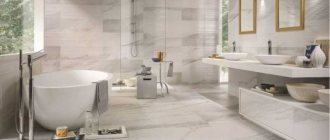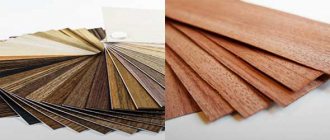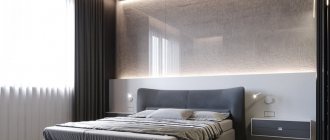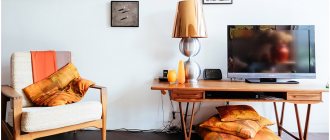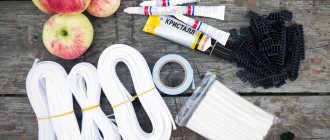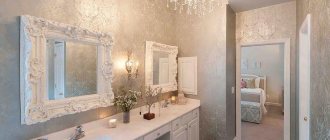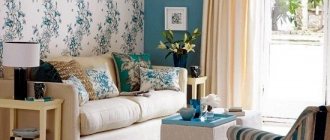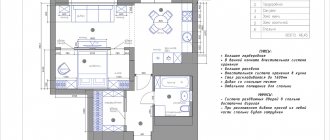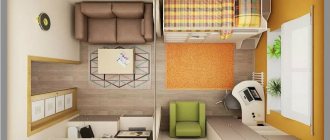32745
Furniture made from solid natural wood is an expensive and not affordable furnishing option for everyone. A good analogue would be veneer furniture, because this material has an external resemblance to solid wood. In the production of this type of product, a base is used, represented by plywood, MDF or chipboard, covered with veneer, which is glued to the base, imitating natural wood.
A LITTLE NOTE BEFORE YOU BEGIN
This is only the fourth article in the series, and the work that I propose to do today may seem quite complicated to you. If so, then first just read this material. Firstly, after reading it to the end, you will be able to see that there is nothing particularly difficult in this work, you only need accuracy and patience. And secondly, it gives us the opportunity to master several important skills at once that will be useful in any other marquetry work, namely:
- preparing veneer for work,
- preparing a drawing for marquetry,
- correct cutting of sharp corners,
- a meaningful cutting sequence that greatly simplifies the work.
And even if you don’t decide to make something like that, your knowledge base will be enriched with useful tips and techniques applicable to pictures of any complexity and any type.
EVERYTHING YOU NEED FOR THIS ARTICLE IS HERE >>>
I already have several works with these polygons. Look how advantageous they look in their own design:
So let's get started.
Pros and cons of stone veneer
Before purchasing stone veneer wall panels, you should familiarize yourself with all the advantages and disadvantages of this finishing material. The advantages include:
- The material is flexible and ductile, so it can be attached to objects of various shapes and sizes.
- Water resistance, due to which stone veneer is used in rooms with high humidity.
- Air permeability, preventing the formation of fungus and mold.
- Durability. If the production and installation technology is followed, the service life of one panel is at least 35 years.
- Light weight and easy installation.
- A rich palette of shades and compatibility with other materials.
Veneer has few disadvantages:
- The material cannot be called completely environmentally friendly, because it contains synthetic components that can cause allergic reactions in rare cases.
- The price of a standard slab is significantly lower than porcelain stoneware, but it is also not a budget material.
Large format or wide format porcelain tiles
As they say: “Yes, you won’t be surprised by the size of ordinary tiles, but what about large-format porcelain tiles measuring 60 by 120 or more.”
You can decorate the bathroom or kitchen with large-format tiles; you can also come up with an interesting solution using tiles in the living room. Its main highlight is the absence of a large number of seams. Also, the material does not deteriorate from mold, but to damage it you need to try.
Please note that wide-format tiles are better suited for large rooms; if you want to use them for rooms with a small area, consult with designers. Make a visual layout in advance to see how your plan will look in real life.
An example of using porcelain stoneware in a modern interior:
Living area with porcelain stoneware wall
Installation features
To prevent stone veneer sheets from losing their appearance, they must be stored correctly, even for temporary storage. The site must be chosen to be completely flat, and the panels should be laid with the front side up and the back side down.
Stone veneer looks organic in any interior. The main thing is to do the work correctly:
- The beginning of the process is traditional for finishing - surface preparation. Any base is suitable: plaster, plasterboard, chipboard panels, fiberboard, MDF, wood. The surface must be flat and smooth, since the finishing material is very thin and any flaws in the base will certainly affect the quality.
- What to glue stone veneer sheets to? The most suitable are dispersion adhesive mixtures based on varnishes (for example, Henkel P685, Soudal Fix Sika Bond T8, D3), as well as waterproof polyurethane glue. You can use adhesive compositions based on ethylene-vinyl acetate copolymers.
- To cut the panels, it is most convenient to use diamond saws, and the edges are ground for better joining and fitting.
- The adhesive composition is applied to the back side of the sheet and allowed to dry a little. the base is also covered with a continuous layer of glue. You can use a roller or a wide brush.
- Then the sheet is pressed tightly to the base. If the surface is horizontal, use a press.
If it is necessary to shape curved sections of the surface or arch, then the workpiece is heated with a construction hairdryer or in another way and bent to the desired radius.
Often the finishing is done with pre-prepared panels, consisting of a substrate with a sheet of stone veneer glued onto it. In this case, for better adhesion of such a panel to the wall, the reverse side is decorated with compensation material. One of the optimal solutions is the use of impregnated paper with a density higher than 150 g/m². If significant temperature changes are possible in operating rooms with stone veneer finishing, then denser materials should be used for the compensation layer.
How to care
When it comes to maintenance, veneer is not too demanding, but it has its own characteristics. It is necessary to take into account that this is, first of all, natural wood, so an appropriate approach is needed.
To prevent the kitchen from losing its appearance, you need to take care of it
For daily care, a soft sponge or lint-free cloth will be enough. Wet them in water and then wipe the surface. After this, wipe dry with a soft towel. If there are stains or stains in the kitchen, you can use a soap solution or a special wood cleaner.
It’s not difficult to clean veneer if you don’t start cleaning
If you decide to use polish, you will need to degrease the surface first. To do this, you can use a weak solution of alcohol or, if desired, a regular window cleaner. Gently wipe the set, wipe it dry, and then apply polish and let it dry.
Important! Never use abrasive detergents or hard sponges. They will scratch the surface and you will need to spend effort and money on restoring the headset.
Stone veneer - what is it?
At all times, decorating a room with natural materials was considered a sign of wealth and luxury. Few could afford stone slabs in the interior. In addition to being expensive, such a material has a high specific weight and installation features in which fastening is only possible on a flat, smooth surface. All the shortcomings that natural stone finishing has were leveled by the discovery of the German Gernot Ehrlich.
While renovating one of the stone countertops, he peeled off a thin surface layer of slate that looked just like the stone. At the same time, the layer was light, moderately elastic and durable. The specialist continued to work in this direction and soon the whole world learned that this was stone veneer. Ehrlich's company began producing building material from a thin slab of natural stone bonded with polyester resin and fiberglass.
Stone veneer - composition
In terms of its composition, composite stone veneer is a hybrid material that combines the gifts of nature and modern scientific developments:
- The top layer is a thin section of slate or marble (0.3 to 2.5 mm thick).
- A special adhesive composition is applied to the stone, connecting it to the substrate.
- When producing flexible stone veneer, manufacturing companies have learned to use a variety of materials as a base, the characteristics of which determine the further use of the product. Fiberglass, cotton, fleece, polyester, and translucent fiber can be used as a substrate.
What is veneer?
Veneer, or veneered MDF, is finely divided boards covered with a thin layer of natural wood up to one millimeter thick. Due to the fact that MDF shavings are impregnated with paraffin or linguine and then pressed under the influence of temperature, the panels are durable and can withstand harsh operating conditions in the kitchen.
A thin cut of natural wood provides a beautiful appearance and is similar in appearance to natural wood. It is glued onto MDF and then coated with varnish or a special paint coating.
Thanks to the protective layer, this headset is very durable
At the same time, veneer can be very diverse: different shades and patterns of wood decorate both traditional and modern kitchens.
Where is stone veneer used?
Many professional designers claim that stone veneer is a finishing material of the future that fits perfectly into interiors of a wide variety of styles. It is used for:
- Production and decoration of furniture for home and office.
- Transparent stone veneer looks great in various backlit art objects, creating an amazing play of light.
- External finishing of fireplace portals, since the material tolerates high heating temperatures well.
- Planning the decor of walls, floors and ceilings in any room.
- Particularly durable panels are used to decorate the facades of offices, shops, cafes and country houses.
Stone veneer furniture
An innovative area of application of stone veneer can be considered the creation of furniture facades:
Kitchens made of stone veneer based on MDF panels are very popular
This material is easy to care for and can withstand severe mechanical and thermal loads, which is very important for kitchen furniture. In addition, the stone goes well with a variety of styles for decorating a room for preparing and eating food.
We will also use the material in the production of furniture for the living room and hall.
You can decorate bar counters, reception desks, and other business furniture with stone panels. In addition, backlit stone veneer looks very original and advantageous, which is also important for a custom-designed interior.
Stone veneer on the facade of the house
Lovers of natural materials prefer facades made of stone veneer instead of the usual plaster and painted layer. The material is mounted on top of the insulation using special glue, which provides the following advantages:
- The stage of so-called “wet operations”, which reduce the durability of the facade, is skipped.
- The technological stage of work is simplified, installation time is reduced to 1-2 days.
- The service life of the facade increases. Stone panels are guaranteed to last for about 50 years, withstanding temperature changes and various atmospheric conditions.
- Façade maintenance is simplified, requiring only occasional cleaning with plain water.
Stone veneer in the interior
In the last decade, flexible stone in the interior has become one of the most popular finishing materials in the mid-price category. Such panels are used for decoration:
- Walls in houses and apartments. The use of the material is especially important in the bathroom, where such panels are a more stylish alternative to the usual tiles.
Offices and commercial premises, especially walls and floors.
Unusual ceilings.
Openings, niches and columns.
Window sills and doors.
Portals for electric fireplaces or facing a classic fireplace with a closed firebox.
Veneer color palette
If you think wood is a boring and monotonous material, then you are absolutely wrong. A wide variety of types of wood are used for veneer, which allows us to provide customers with a wide range of coatings of the most unusual appearance.
Veneer kitchens can be very diverse
Luxurious oak facades will suit both classic and modern interiors. Oak wood can have different shades, but its characteristic feature is its unusual rounded patterns that add gloss and nobility to even the simplest furniture.
Black oak veneer kitchen - for lovers of expensive elegance
Alder veneer is distinguished by its delicate, light color and velvety-looking texture. It is perfect for kitchens in country style, Provence. Another advantage of alder is its high resistance to mechanical stress. Very often, such a coating is not even varnished, since it already tolerates moisture and temperature changes very well.
Alder is ideal for most interiors.
A set with a rosewood facade will cost you quite a lot. However, unusual patterns and textures of wood are definitely worth the expense - the kitchen will look truly luxurious and elegant.
The peculiarity of cherry veneer is its reddish tint. It is perfect for a Baroque style kitchen. Moreover, cherry panels do not fade over time, but, on the contrary, the shade becomes much deeper and more noble.
The peculiarity of a cherry kitchen is its deep color
The cool, light shade of ash is ideal for small kitchens or south-facing spaces. Ash must be treated with varnish or a special protective coating, otherwise the color very quickly becomes dull, losing its charm.
Walnut veneer has a rich structure. Depending on the type and age of the tree, the shade may vary, but always remains consistently warm. Such facades will decorate kitchens facing north and will slightly dilute the lack of light.
Walnut kitchens are always distinguished by warm tones
A fashionable way to process veneer is zebrawood. The unusual striped color looks very expensive and unusual, and therefore will suit both classic and modern interiors.
Zebrawood is a modern and very fashionable type of veneer
As you can see, choosing the right option for a veneered kitchen is not difficult - the main thing is to find the type that you like.
Veneered kitchens are easy to find to suit every taste
In addition, you can radically change even the appearance of the familiar alder by applying a special varnish or protective coating to the facade. Depending on your choice, veneer can acquire a matte or glossy texture. The first option is ideal for classic kitchens - it looks elegant, restrained and rich. Shiny glossy options will fit well into modern interiors and visually enlarge a small kitchen.
The glossy structure is suitable for modern interiors.
Matte veneer looks very noble
Scope of application of stone veneer
- Furniture production
: kitchen and more. In particular, stone veneer is used to create rounded surfaces. - Cladding of walls, columns, furniture, floors
. Stone veneer with a reinforced surface is suitable for floor cladding. - Creation of mosaics
: wall, floor, etc. The seams are rubbed with special waterproof compounds. - Manufacturing of commercial equipment
: both individual products and the entire interior for a cafe, office, store, etc. - Making stained glass and other products
: transparent stone veneer allows light to pass through, and therefore can be used to cover backlit products. - Finishing the facades of houses
is another area of using flexible slate. This cladding will not crack or fade.
What is veneer called?
Veneer is a word of German origin meaning wood chips. Apparently, at the time the term was borrowed, they were synonymous. Nowadays, wood chips mean chopped wood. There are several types of wood chips, the best of which are called technological. After additional chemical treatment, some of them are used in the production of boards from wood fibers and chips.
All modern types of veneer are obtained by more subtle mechanical methods of wood processing, for which special technological equipment is used. As a result, plates of small thickness and relatively large (for crushed raw materials) surface area are formed. They don't look like wood chips at all.
The advantages of veneered products are as follows:
- the coating has a beautiful pattern, which is further enhanced during processing;
- veneer of exotic species can be used to decorate a base made of inexpensive wood;
- in case of minor damage, the appearance of the surface can be easily corrected by minor repairs;
- veneer allows you to restore old structures and products without large financial costs;
- a thin layer of coating allows you to carry out the work yourself using ordinary tools.
When working with solid natural wood, you have to make a lot of physical effort, use woodworking machines and special tools, but working with veneer is much easier.
Operation and installation
To ensure that natural veneer does not prematurely lose its qualities, it must be folded and stored correctly. The site for this should be selected as flat as possible, and the panels should be laid face up. Whatever the interior, stone veneer will look as attractive as possible. The main condition for a successful result is correct installation.
- First you need to properly prepare the surface. In this case, the base can be plasterboard, plaster, chipboard, fiberboard and MDF. The main thing is that the surface is even and smooth.
- Gluing sheets of natural veneer should be done using a dispersion adhesive mixture with a varnish base. Alternatively, you can use glue with a waterproof polyurethane or ethylene-venyl acetate base.
- To cut the product, it is better to use a diamond saw. The edges should be sanded to ensure good joining and fit.
- The glue must be applied with a roller to the back side of the veneer and left to dry. An adhesive substance is also smeared onto the base.
- The veneer sheet must be pressed tightly against the main surface. In some cases, styling is impossible without a press.
If it is necessary to design a curved section or arch, the workpiece is heated in advance. Unfortunately, one sheet of veneer is not always enough to cover a wall, so the master has a new task, namely, sealing the seams. To solve the problem, experts recommend using moisture-resistant epoxy grout. Since this substance is sold in various colors, the consumer can easily choose the option that best suits the stone veneer.
Stone veneer Classic
Classic stone veneer from the Slate Lite brand is a durable and reliable four-layer material. Its structure includes directly slate, polyester resin, fiberglass and a substrate made of any material (based on the scope of application).
Classic stone opaque veneer is used for cladding buildings, floors, walls, ceilings, fireplaces, columns; production of furniture, facades, countertops and design elements.
We do not produce stone veneer ourselves, but we cooperate with it. If you would like to have stone veneer in your interior, our specialists will not only help you choose, but will also make any product from flexible slate for you.
Slate Lite stone veneer is a reliable, innovative material that is natural, safe and durable.
Reviews about veneered kitchen
Especially for you, we have collected several reviews from users of veneer sets. We are sure that after reading them, you will easily make a decision and understand whether you want to purchase such a kitchen.
The advantage of veneer is that abrasions do not spoil it, but, on the contrary, add charm.
Veneer is a simple and easy-to-maintain material that does not require special care.
The main thing is to at least occasionally wipe the veneer from dust and dirt.
Choose a high-quality kitchen and there will be no problems.
Peeling varnish is easy to renew, but durability is a definite plus.
VENEER MARQUETRY – MANUFACTURING TECHNOLOGY: VIDEO
Craft 45: Marquetry Technique
Master class on wood mosaics Marquetry
- DIY device for folding clothes CONVENIENT DEVICE FOR FOLDING CLOTHES To…
- Bent wood with your own hands How to bend a tree with your own hands...
- DIY pumpkin bouquet - master class and photo DIY pumpkin bouquet Often...
- Do-it-yourself wet facade Technology of “wet facade” using an example...
- Do-it-yourself tiled table - decor Decor of an old table Many people have somewhere...
- Stable folding trestles for the workshop with your own hands - photo and drawing Folding trestles for the workshop with your own...
- A box with a secret with your own hands - photo master class BOX PUZZLE WITH YOUR OWN HANDS STEP BY STEP Today...
With your own hands › Carpentry › Do-it-yourself veneer mosaic (marquetry) - a beautiful master class
Varieties and sizes
There are currently several varieties of stone veneer on the market.
- Slate Lite. This material, which is made of stone, has high strength and a large thickness of the inner layer. It contains slate, fiberglass and backing. This type of veneer is used for facade cladding, interior and exterior finishing. The seamless texture of the sheet allows it to be laid on metal, concrete, brick and wood surfaces.
- Eco Stone is a natural stone veneer with a natural cotton backing. Flexible and thin material is used to cover walls, furniture and interior items.
- Translucent is a transparent stone veneer that is used to decorate illuminated rooms. It is characterized by brightness and effectiveness, so it is often chosen by consumers.
With the help of composite marble veneer, you can make your life more original. Materials like marble, white, onyx, granite, black, light gray and others are simply irreplaceable for decorating columns, walls, partitions.
Veneered wood panels for the wall
Veneered panels are the favorites of those who want to choose a finishing material whose price is 100% consistent with the quality. Having all the advantages of natural materials (environmentally friendly, durable, resistant to damage), they are cheaper.
Having given preference to veneer panels, the owners of the room can play with shades, the choice of which is huge.
This material is used both in residential buildings and apartments, as well as in office premises or conference rooms for wall panels, doors and furniture panels.
An example of using wooden panels in a modern interior:
Wooden panels in the bedroom interior
Advantages of using stone veneer in the interior
1. The sheets are suitable for exterior and interior decoration.
2. The flexibility of the material allows it to be used on curved surfaces.
3. Standard varnishes can be used for protective treatment of veneer. Over time, they will make the surface color deeper and more saturated.
4. Installation of sheets is simple and quick, since their standard sizes are quite large (610x12200 or 1220x2440 mm).
5. A thin fiberglass backing creates a waterproof barrier in the veneer. It also gives the material additional strength.
6. The light weight of the sheets makes them easier to transport and install.
7. Cutting stone veneer sheets can be done with any carbide carpentry tool or metal scissors.
8. To attach veneer to the surface, you can use a wide variety of compounds: PVA, contact, construction, epoxy and other adhesives.
9. The sheets are perfectly attached to concrete, brick, plywood, chipboard, MDF and other surfaces.
10. Stone veneer combines a rich array of colors and textures.
Veneer in different interiors
At the dawn of its appearance, veneer served to “create the appearance” of luxury. It was used for furniture that was mid-priced but still looked presentable. Of course, her designs were mostly classic.
Now veneer in the classics is no less relevant. But modern interiors have also appeared in which it looks no worse. For example, facades and buildings of restrained rectangular shapes, but with a pronounced wood texture, fit well into minimalist and technocratic interiors, adding a lively note to them.
One of the advantages of veneer is the ability to decorate curved surfaces with it. Experimental designers take advantage of this, creating the most unusual and bizarre furniture.
And finally, veneer inlays are not a thing of the past: with the help of this technique, real works of art are born.
How to glue stone veneer?
For professional craftsmen, finishing walls with stone veneer is an easy type of work that can be done in a relatively short time. With the proper skills and tools, an ordinary person can also cope with this task. Stone veneer can be glued to flat and curved surfaces from:
- metal;
- concrete;
- plywood;
- wood;
- Chipboard and MDF;
- ceramic tiles;
- drywall.
Pasting stages:
- Leveling the surface from significant irregularities.
- Dust removal with a special primer if necessary.
- Marking and drawing up a sheet layout plan.
- Some craftsmen advise protecting the edges of the panel with masking tape from the adhesive.
- Dilution of glue. It is applied to the panel and surface with a special notched trowel using a zigzag motion.
- The panel is pressed against a section of the wall, smoothed and fixed by hand for about 10 seconds.
Stone Veneer Adhesive
In order for stone veneer on a wall or other surface to hold firmly and last for the number of years stated by the manufacturer, it is important to choose the right adhesive composition. Professionals recommend using two-component adhesives or sealants based on:
- polyurethane compounds, for example, Tenax Titanium;
- dispersion varnish compositions, for example, Stauf D3;
- epoxy resins, for example Litokol Litoelastic;
- silicones, which are used in Iposkol brand compositions, for example;
- hybrid polymer mixtures (MS polymers), for example, sm Soudal.
Areas of use
Stone has long been a priority when decorating walls, as well as kitchen furniture facades. Provided that the texture is selected correctly, the master can achieve a unique design solution in his room.
Stone veneer has found its application in the following cases:
- cladding of walls and interior partitions;
- finishing of various niches;
- furniture cladding;
- covering columns and other structures with a semicircular shape;
- base for a wall panel.
Thin and light veneer sheet looks great both in a public place and in a cozy home room. In order to decorate a room, it is not necessary to cover all the walls with this material; you can decorate picture frames with it. This interior is characterized by sophistication and completeness. Many craftsmen recommend including natural veneer in the design of an interior or entrance door.
Types of frames
Interior veneer doors use a hollow frame or one that has a base of laminated veneer lumber.
Spectacular veneered interior door
To create the frame of a hollow structure, well-dried pine beams (humidity no higher than 8%) are used. In cases where it is planned to install glass in the door, a frame is also made around the perimeter of the future insert.
MDF sheets are nailed over the frame, and the cavity inside is filled with honeycomb cardboard or polystyrene foam.
Veneer sliding doors
Contrasting combination of dark door and white interior
Before veneering, sheets of the required size are created from veneer strips. They are selected according to texture, soldered together on special machines and excess glue is removed.
Having adjusted the sheet to the size of the frame, it is glued. After which the product is sanded and varnished.
Veneer door structure
In a continuous structure made of beams, not only the frame is created, but also the entire base. The further processing procedure (coating MDF, gluing veneer) is the same as for hollow structures.
Veneered door made of laminated timber with glass inserts
Hollow structures are lighter, but also less durable.
For entrance doors, as a rule, metal frames are used, upholstered in MDF and then covered with veneer.
Interior doors and walls, finished with the same veneer, look very interesting
Veneered laminated timber family room door
Application in the interior
Natural stone veneer is widely used by designers in the design of premises for various purposes. Its rough surface makes it possible to use the material when decorating furniture, carriages and yachts.
Veneer sheets are used for laying paths, steps, facing foundations and facade walls. Stone veneer can be used even in damp rooms, for example, when decorating a bathroom. This material, installed on ceilings, walls, floors and fireplaces, creates the atmosphere of an aristocratic interior in the living room.
Thin and light sheets look equally good both in public places and in cozy home rooms. All walls of the room do not have to be made only of veneer. Some owners prefer to make only picture frames out of it. In this case, the interior already looks complete and sophisticated. Another option for partial decoration with veneer is its inclusion in the decoration of entrance and interior doors.
Decor
Despite the fact that veneer itself is a material with a smooth structure, very often veneered kitchens are decorated with various decorative elements. For example, carved elements made of natural wood. They significantly increase the cost of your kitchen, but the appearance only benefits from it.
Curly veneer facades are expensive, but the appearance is stunning
Often, various ornaments are used as decoration for veneered kitchens: ethnic, floral, geometric motifs. We recommend choosing depending on the design style of your kitchen.
And sometimes the texture of the wood itself becomes a decoration
If you have a small kitchen, voluminous decorative elements may not be very appropriate: they will visually make the room even smaller. However, in this case, you can experiment with different textures. For example, a special primer helps to visually age the set - an excellent solution for classic kitchens or baroque-style rooms.
Aged veneer - another fashionable technique
As an option, try choosing a suitable shade and applying a patina. It makes even the simplest set look elegant and expensive.
With patina, veneer looks more noble
Impregnation for stone veneer
By its nature, slate is a porous material that can absorb moisture, fats and other substances. To minimize damage to the surface after installation, special impregnations - impregnates - must be applied to the panels. This treated flexible stone finish will not only last longer, but will also have a more attractive appearance.
The following compositions can be used:
- Water-based impregnations
are used on panels located in dry rooms and without large mechanical loads, for example Henkel Ceresit CT17. Such compositions protect the material from dust deposition. - Acrylic impregnations
, such as IPKOM (IP-01) EcoCristal, have greater strength and protection from moisture, therefore they are suitable for kitchen facades and aprons, panels for bathrooms, halls and corridors. - Polyurethane compounds
are considered the most durable and help protect canvases from external influences of an aggressive environment, such as atmospheric conditions. One of these is the façade semi-matte varnish IPKOM (IR-15).
PREPARATION OF THE FIGURE
I’ll immediately explain why we specially prepare the drawing, and don’t take it and immediately start cutting it. Firstly, the work is educational, and the process is more important than the result. While preparing a picture from scratch, you will begin to develop the skill of developing any drawing: something geometric, a flower, a river with a house. Secondly, during preparation you comprehend the drawing: you understand how, where and why each line goes, how to cut or saw it later and what color it should be. Therefore, if you don’t have someone behind you who will always tell you, show you and give you the right veneer, then learn from scratch and thoroughly, doing every job 110%. This is the only way you will see your skill grow.
We print out the desired design and trace the contours of future veneer inserts. Everything is simple here.
Who has seen paint-by-numbers, where each number is a specific color? Our task is to do the same with the layout.
FIRST STEP.
Determine the light source. My light will fall from the right, from the front (I draw an arrow). Now we strain our spatial imagination and see on which faces the light will fall directly, illuminating them as much as possible. All these edges are marked with the number “1” (the lightest veneer). You can look at the source code, but you still need to independently imagine and comprehend each facet. Leonardo da Vinci will not color other drawings for you, learn to work on your own.
THIRD STEP.
The sides that are slightly turned away from the light are the number “2”, and those that are slightly turned away from the full shadow are the number “3”. Ready.
With a palette of six gradations, the steps are the same: first the extreme values, then little by little we move away from them. If some line is unclear, leave it and fill in everything that is clear. Then go back to the blank and look. Most likely, it will be parallel to some already marked side, so little by little everything will be filled.
And we remember that the layout for marquetry is made in a mirror projection, because the side that will be the front side for us during work is then used for gluing onto the base, i.e. the design is turned over. Our pyramid, of course, is symmetrical, but still, hanging it on the side of a window or other light source, the picture will look more natural if the light on it is located the same way as it falls in life.
Properties and characteristics
If the technology for finishing with stone veneer is correct, it will be quite difficult for the consumer to distinguish it from natural slate. However, it is worth noting that veneer is characterized by greater mobility, pliability and is lighter than stone. The presence of a fiberglass base and resins in the composition of the material contributes to its pliability and easy bendability. For this reason, it is almost irreplaceable when finishing surfaces with a complex or curved texture.
Stone veneer can be used to decorate the interior of the bathroom and dining room. Thanks to a wide range of panels, everyone can choose the ideal option for their interior.
Advantages of the material:
- environmental Safety;
- wear resistance and water resistance;
- possibility of use in hard-to-reach places;
- light weight and small layer thickness, equal to no more than 2 mm;
- non-flammability;
- ease of installation.
There are practically no disadvantages to stone veneer.
Using stone veneer for interior decoration in a private home
When developing a private house project, many factors and quantities are taken into account. Mandatory calculation requires the load created by the building on the foundation. The lighter the material of the house, the cheaper the foundation will cost. Cladding with natural stone looks very impressive; in addition to the high price, this finishing method is very heavy. Each slab measuring 2500x1500 mm weighs about 300 kg.
There is always a way out of such a situation. The house can be finished with stone veneer. Relatively lightweight sheets are easy to transport and install. Thus, the load on the foundation is reduced, and the appearance of the building is almost not affected. This is confirmed by numerous positive customer reviews.
Where is slate veneer used?
The possibilities for using stone veneer are unlimited. This material is used to decorate almost any indoor surface, as well as decorative items. The canvases are light in weight (no more than 1.6 kg), so they are easy to work with. Slate veneer is used for:
- cladding walls, partitions, columns, ceilings in premises for almost any purpose;
- production of countertops, shelves, niches, bar counters;
- design of kitchen furniture facades, interior doors, cabinets with hinged and sliding doors.
The thinnest stone veneer Slate Lite deserves special attention. Its thickness does not exceed 2 mm. Light weight and high flexibility make it unique. And such qualities as natural origin, durability and the ability to transmit light are used in the production of lampshades for ceiling, floor, wall, and street lamps. These same properties are widely used in the creation of individual decorative items and souvenirs.
